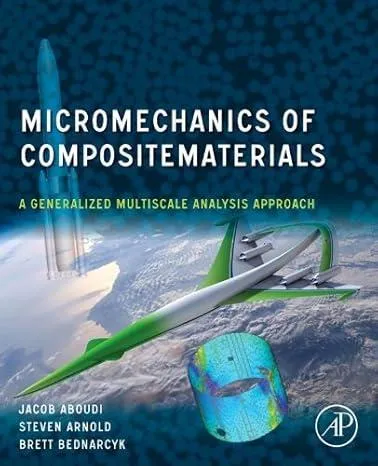Arnold Multiscale Modeling LLC

MISSION STATEMENT
Steve Arnold - NASA · Materials and Structures Division PhD
Our mission is to empower present and future generations by offering expert guidance, training, and consulting services to our clients in the fields of engineering solutions, nonlinear material behavior, multi scale modeling, and materials information management.
Our commitment to integrity and excellence drives everything we do.
Our goal is to assist individuals and organizations in achieving their goals through the application of expert knowledge in advanced engineering principles and techniques.
Our Work
PUBLICATIONS
Dr. Steven M. Arnold’s extensive body of work and contributions to the field of multiscale modeling and materials science are a testament to his dedication and expertise. Explore these resources to gain deeper insights and advance your knowledge in the field.
1. Books
Micromechanics of Composite Materials: A Generalized Multiscale Analysis Approach (2013)
Authors: J. Aboudi, S.M. Arnold, and B.A. Bednarcyk
Publisher: Elsevier, Oxford, UK
Year: 2013
Description: This comprehensive text covers the fundamentals of micromechanics, including the Method of Cells Micromechanics, Generalized Method of Cells, and High-Fidelity Generalized Method of Cells. It is an essential resource for understanding multiscale analysis and the behavior of composite materials.

Table of Contents
Table of Contents
Introduction
Constituent Material Modeling
Fundamentals of the Mechanics of Multiphase Materials
The Method of Cells Micromechanics
The Generalized Method of Cells Micromechanics
The High Fidelity Generalized Method of Cells Micromechanics
Multiscale Modeling of Composites
Fully Coupled Thermomechanical Analysis of Multiphase Composites
Finite Strain Micromechanical Modeling of Multiphase Composites
Micromechanical Analysis of Smart Composite Materials
Higher-Order Theory for Functionally Graded Materials
Wave Propagation in Multiphase and Porous Materials
Micromechanics Software
Practical Micromechanics of Composite Materials (2021)
Authors: J. Aboudi, S.M. Arnold, and B.A. Bednarcyk
Publisher: Elsevier, Oxford, UK
Year: 2021
Description: This book provides a practical approach to micromechanics, with extensive examples and exercises. It includes MATLAB code to help solve real-world micromechanics problems and is a valuable tool for both students and professionals in the field.

Features
Thermoelastic Material Behavior
Emphasis on Local fields via Strain and Stress Concentration Tensors;
General MATLAB open-source code provided
Four micromechanics theories MT, MOC, GMC, HFGMC
Four failure criteria, along with consistent treatment of Margins of Safety (MoS)
Emphasis on PMC & CMC, order and disorder microstructures
Extensive Practical Examples; ~ 15 Exercises /Chapter (Solution Manual available to professors)
2. Technical Publications
Dr. Arnold’s extensive research portfolio covers a wide range of topics
in materials science and engineering. Over 525 technical publications,
including:
119 journal articles
3 co-edited special issues on Functionally Graded Materials
4 book chapters
10 NASA Tech Briefs.
Dr. Arnold’s extensive research portfolio covers a wide range of topics in
materials science and engineering.
• Selected Publications
Arnold, S.M., Goldberg, R. K., Lerch, B. and Saleeb, A.F. “An Overview of Structural Prognosis Health Management Research at Glenn Research Center for Gas Turbine Engine Structures With Special Emphasis
on Deformation and Damage Modeling, NASA/TM – 2009-215827, 2009.
Arnold, S.M., Cebon, D., and Ashby, M.; “Materials Selection for Aerospace Systems”, NASA/TM-2012-217411.
Arnold, S.M., Holland, F.A., Bednarcyk, B.A., and Pineda, E.J.; “Combining Material and Model Pedigree is Foundational to Making ICME a Reality”, Integrating Materials and Manufacturing Innovation, IMMI, 4:4, 2015
Arnold, S.M.; “The Convergence of Materials Science and Structural Analysis: Multiscale Modeling for ICME”, Benchmark Magazine, NAFEMS, January 2018
Lerch, B. A., and Arnold, S. M.; “Exploration of Failure and Potential Damage Markers in Ti-6Al-4V, NASA/TM-2019-219902, 2019
Pineda, E.J., Bednarcyk B.A., Ricks T.M., Arnold, S.M., Henson, G. "Efficient multiscale recursive micromechanics of composites for engineering applications", International Journal for Multiscale Computational Engineering (IJMCE) Special Issue: Revolutionizing Engineering Practice by Multiscale Methods, 19(4), pp 77-105, 2021.
Stuckner, J., Piekenbrock, M., Arnold, S.M., and Ricks, T. ; “Optimal Experimental Design With Fast Neural Network Surrogate Models, Computational Materials Science (0927-0256), Vol 200, No. 3, pp. 110747,
2021.
Hearley, B. L. and Arnold S.M.: “NASA GRC ICME Schema for Materials Data Management: An Executive Summary”, NASA TM-20230018337, 2023
3. Patents
Dr. Arnold has submitted 14 NASA Invention Disclosures, with two awarded U.S. Patents:
U.S. Patent No. 7,416,062 B1 “Torsional Magnetorheological Device”
U.S. Patent No. 7,458,221 B1 “Variable Area Nozzle Including a Plurality of Convexly Vanes with a Crowned Contour”
WORK PROCESS
Our working Process
Discover
This involves gathering comprehensive information about the client's income, expenses, assets, liabilities, investment preferences, and any specific financial concerns.
Finance Cost
This involves assessing the client's budget, debt obligations, existing investments, insurance coverage, and any other financial commitments.
Plan
This plan outlines specific strategies and recommendations to help the client achieve their financial goals.
Delivery Task
This step involves explaining the rationale behind the proposed strategies, illustrating potential outcomes, and addressing any questions or concerns the client may have.
OUR TEAM
Lorem ipsum dolor sit amet, consectetur adipisicing elit. Autem dolore, alias, numquam enim ab

Jane Doe

Jane Doe

John Doe
FAQS
What is the importance of financial planning?
Financial planning is crucial for several reasons. It provides a roadmap to achieve your financial goals, whether it's buying a house, funding your children's education, or retiring comfortably. Through proper planning, you can identify potential risks, such as inadequate insurance coverage or investment volatility, and take steps to mitigate them. Additionally, financial planning helps you make informed decisions by evaluating various options and their potential outcomes. It also ensures that your resources are allocated efficiently, enabling you to manage debt, taxes, and expenses effectively.
How does risk tolerance affect investment decisions?
Risk tolerance refers to your willingness and capacity to withstand fluctuations in the value of your investments. It varies from person to person and is influenced by factors like age, financial goals, and personal preferences. Understanding your risk tolerance is crucial because it guides your investment decisions. If you have a high risk tolerance, you might be more comfortable with aggressive investments that offer higher potential returns but come with greater volatility. On the other hand, if you have a low risk tolerance, you might lean towards more conservative investments with stable, albeit potentially lower, returns. A financial advisor can help align your investment choices with your risk tolerance to create a balanced and suitable portfolio.
How does estate planning benefit my loved ones?
Estate planning involves creating a plan for how your assets will be managed and distributed after your passing. It's not just for the wealthy; it's about ensuring your wishes are carried out and minimizing stress for your loved ones during a difficult time. Through estate planning, you can specify beneficiaries for your assets, designate guardians for minor children, and even make provisions for charitable contributions. Estate planning can also help minimize estate taxes, legal fees, and potential conflicts among heirs. By putting a comprehensive plan in place, you provide your family with clarity and financial security, ensuring that your legacy is preserved and your loved ones are taken care of according to your wishes.




